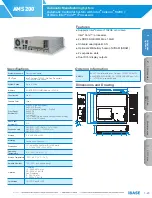
Model 30000-S DHPU Manual
Rev. 0
JRK
17SEP12
Page 19
1500 PSI, the pump should shift from high flow to low flow. If it does not shift at 1500 PSI,
then shut down the power unit and repeat the adjustment on the HP-1 sequence valve.
Continue this trial and error method until the correct setting is achieved. The maximum
valve setting is determined by the maximum power the motor can deliver. Increasing the
valve setting would increase the required torque from the motor at a higher flow (more
power); raising it too high would cause the motor to stall.
Relief Valve
A relief valve (RV-1) is directly bolted onto the pump's output. This valve limits the
maximum pressure on the circuit as mentioned in the system's safety feature section.
Heat Exchanger and Heat Exchanger Hydraulic Pump
The unit incorporates an air over oil heat exchanger (HX-1) driven by a hydraulic motor.
The heat exchanger always runs as long as the power unit motor is running. The hydraulic
pump (HP-2) for this circuit is mounted on the motor's auxiliary pad as shown below.
Figure 11: Heat Exchanger and Pump
Heat Exchanger Motor Flow Control Valve
Flow to the heat exchanger hydraulic motor is limited by the control valve (FCV-1) shown in
the following photo. This valve keeps the speed of the heat exchanger fan constant no
matter if the engine is at full or idle speed. This valve is non-adjustable.
Heat Exchanger Motor Relief Valve
The pressure on the heat exchanger hydraulic motor is restricted by the relief valve (RV-2).
This valve is set during the initial test and should not be adjusted in the field.









































